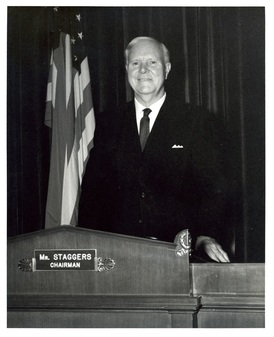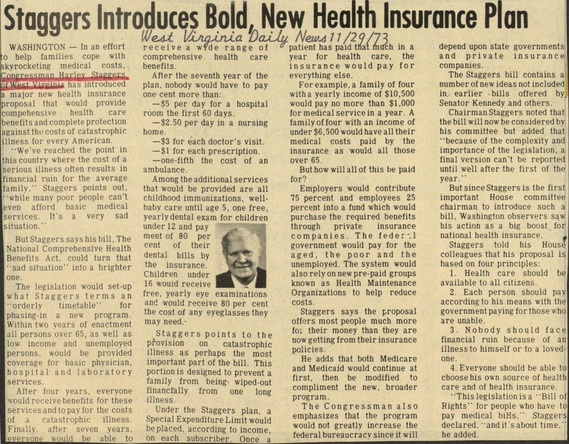|
Note: This post was previously listed under our "News from the Grey Box" blog series By Jody Brumage In 2010, Congress passed the Affordable Care Act (ACA). This landmark legislation brought over a century of health care reform debate in the United States to a new incarnation. In 1973, an attempt to pass legislation similar in nature to the ACA was introduced in the House of Representatives, sponsored by Congressman Harley O. Staggers, Sr., of West Virginia. The first efforts to create national health care programs were rooted in the Progressive Era beginning in the early 20th century with attempts to pass legislation beginning in the 1910s and achieving some success with the passage of the Social Security Act of 1935.[1] Eight years before Staggers’ health care bill, President Lyndon Johnson signed the Social Security Act of 1965, creating Medicare and Medicaid. These programs represented the most significant effort up to that time to implement a national health care system in the United States, building upon the foundation of the 1935 act. However, proponents of a more robust program felt that Medicare and Medicaid did not go far enough to provide health care for American citizens. Congressman Staggers introduced his legislation, named the National Comprehensive Health Benefits Act, on November 8, 1973 in the middle of the 93rd Congress and amid calls for such reform from the Nixon Administration. The proposed act contained several components that would have revolutionized health care in the United States, including free medical care for children, price caps on medical services, protection from catastrophic illness, and insurance rate caps based on a subscriber’s income. In a press release from Staggers in late November, 1973, the Congressman stated “that both Medicare and Medicaid would continue at first, then be modified to complement the new, broader program.” Similar to the ACA almost 40 years later, Staggers’ health care plan called for the combined efforts of private and public insurance providers to lower costs. The bill was constructed around four principles which were echoed during the campaign for the ACA: “health care should be available to all citizens,” “each person should pay according to his means,” “nobody should face financial ruin because of an illness,” and “everyone should be able to choose his own source of health care.” Despite the inclusion of ideas which had been debated in Congress for over a decade and its modeling on earlier acts proposed by Senator Ted Kennedy and others, Staggers’ bill died in committee. While the bill was being reviewed in the House Committee on Energy and Commerce in 1974, Congress’ attention was captured by the Watergate Scandal. Within the committee, Staggers was facing challenges from members of his own party and, following that fall’s election, he lost his subcommittee chair to freshman Congressman John Moss (D-CA).  Congressman Staggers, Sr., at his chair on the Foreign and Interstate Commerce Committee. Congressman Staggers, Sr., at his chair on the Foreign and Interstate Commerce Committee. Staggers’ reintroduced his bill in the 94th Congress, but again, it met its fate in committee, this time his own, the House Committee on Interstate and Foreign Commerce. Despite this loss, Staggers’ Committee did construct three health bills which passed the House but not the Senate, and in the summer of 1975, Staggers cast his vote in favor of overriding President Ford’s veto of the Public Health Service Act. The National Comprehensive Health Benefits Act never made it to the floor for a vote, and Congressman Harley Staggers, Sr., later became nationally recognized for his work in transportation reform. However, his work on this bill and other health care incentives impacted the debates regarding national health care in the United States long after he left office in 1980. [1] Palmer, Karen. “A Brief History: Universal Health Care Efforts in the US.” Physicians for a National Health Program. January 1, 1999. Accessed September 2, 2014. Comments are closed.
|
Welcome to the Byrd Center Blog! We share content here including research from our archival collections, articles from our director, and information on upcoming events.
Categories
All
Archives
July 2023
|
Our Mission: |
The Byrd Center advances representative democracy by promoting a better understanding of the United States Congress and the Constitution through programs and research that engage citizens.
|
Copyright © Robert C. Byrd Center for Congressional History and Education
|


 RSS Feed
RSS Feed
